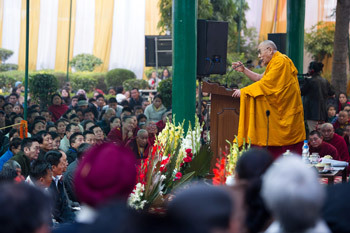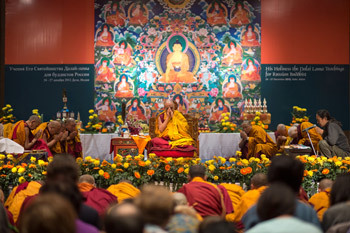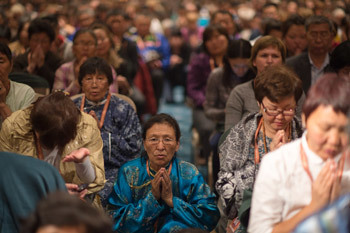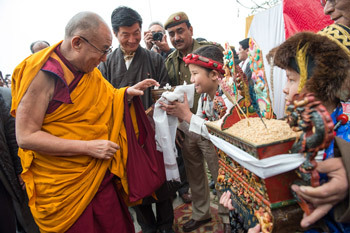New Delhi, India, 26 December 2012 - On his way to the teaching venue this morning, His Holiness the Dalai Lama stopped off to attend a celebration of the Golden Jubilee of the Samyeling Tibetan Settlement at New Aruna Nagar, popularly known as Majnu ka tilla. He was received at the gate of TCV Day School by the Settlement Officer, Mr Lekyi Dorjee Tsangla and offered a traditional Tibetan welcome. He briefly took his seat on the throne to receive the customary threefold mandala offering before moving to a chair closer to the front of the stage. Tea and sweet rice were served while the Settlement Officer made his report, which was followed by a speech by the Sikyong, Dr Lobsang Sangay.
He began by stating that Tibetans in Tibet as well as in exile retain a strong spirit. Alluding to the 95 self-immolations that have taken place recently in Tibet he said the principal cause was the sense of desperation among Tibetans there. Despite the Chinese authorities trying to pin the blame for instigating them on the exile community, the Sikyong felt there is an increasing international acknowledgement that it is the way China has dealt with Tibet that has led to this tragedy.
He recalled that during his own six years as a student in Delhi he often joined members of Samyeling Settlement in demonstrations on behalf of the Tibetan struggle. He counselled those who demonstrate today to observe non-violence and remain within the law. He described the Tibetan people as supremely fortunate to have a leader of His Holiness’s great standing in the world and declared his belief that if Tibetans can maintain unity in their struggle they can achieve the aim of seeing him return to Tibet. Finally, on behalf of all Tibetans, he offered thanks to the people and government of India for the immense kindness they have shown them.
The local Indian MLA and Kalon for Home Affairs, Mrs Dolma Gyari spoke encouraging words. His Holiness was requested to present mementos to the various guests and dignitaries before being invited to speak. He greeted all present with “Tashi Delek.” He said,
“I know that Chief Minister Mrs Sheila Dixit and former Deputy Prime Minister Mr LK Advani wanted to be here, but circumstances have prevented them from attending. I believe they are with us in spirit. The Sikyong and Kalon have spoken about the present situation and I don’t have much to say.”

|
His Holiness the Dalai Lama speaking at the celebration of the Golden Jubilee of the Samyeling Tibetan Settlement in Delhi, India, on December 26, 2012. Photo/Tenzin Choejor/OHHDL
|
He talked about trying his best to help humanity and reduce suffering. Happiness depends on the mind, which is why it’s important to understand how the mind works. What has to be transformed is the mind and it can only be transformed by the mind itself. To think only of achieving victory over others is futile and will not lead to happiness. He said there are so many sources of trouble in the world, and religion should be able to contribute to solving them. This will not happen if misunderstanding and mistrust between our religious traditions continues to prevail. This is why he has committed himself to fostering greater religious harmony.
His Holiness also praised the qualities of the Tibetan language, describing it as something all Tibetans could be proud of.
“Tibetan is much better suited to expressing ancient Indian thought than English or French. It is a rich language, but it is up to you young people to bring it up to date. The 300 volumes of the Kangyur and Tengyur, which are written in Tibetan, describe not only Buddhist religion, but also Buddhist science and philosophy. In this 21st century it would be much more appropriate to read these books instead of keeping them in a cabinet and treating them as objects of offering.”
Arriving at the teaching venue, the Kempinski Ambience Hotel, His Holiness lost little time taking his seat and commencing the preparatory rituals for the Medicine Buddha permission he was going to give. Meanwhile the Heart Sutra was recited in Buryat, after which he asked the audience to recite the verses of chapter two and up to verse twenty-three of chapter three from the Guide to the Bodhisattva’s Way of Life, which constitute the Seven Branch Practice. Regarding the ceremony to generate the aspiring and engaging awakening minds of bodhichitta, he said that while it can be done before an image, it seems to be more effective if it is done before a mentor who also acts as a witness. He also clarified that the first two lines of the verse he would ask them to recite dealt with taking refuge in the Buddha, Dharma and Sangha and that the last two lines dealt with the aspiration to attain enlightenment. Then, reciting two verses from chapter three of the Guide involved generating the aspiring awakening mind and taking the bodhisattva vows.

|
His Holiness the Dalai Lama during the third day of his four day teaching to group from Russia in Delhi, India, on December 26, 2012. Photo/Tenzin Choejor/OHHDL
|
“May I attain enlightenment for the sake of all sentient beings; and may I eliminate all defilements and achieve all qualities.”
“We can see that enlightenment is possible,” he said, “because there is no difference between the empty nature of our minds and the mind of a Buddha. Because the mind is empty of intrinsic existence, we can talk about eliminating defilements. They dissolve into suchness and when they do that we are purified of negativities. And as we purify our negativities we also develop the positive qualities of a Buddha.”
His Holiness went on to discuss the nature of the clarity and awareness of the mind, saying that although nothing can put an end to that clarity and awareness, the defilements of the mind can be eliminated.
Regarding the lineage of the Medicine Buddha practice whose permission he was giving, he said this derived from a pure vision of the Fifth Dalai Lama. He joked that while the 2nd, 3rd, 5th and 13th Dalai Lamas all had visions, the 14th has had none at all, and yet the 14th seems to be the most popular Dalai Lama.
About the advantages of the Medicine Buddha practice His Holiness said that if we do the practice and observe the retreat, we can reap the benefit of overcoming illness.
In the afternoon, His Holiness gave the transmission of the verses of the second and third chapters of the Guide to the Bodhisattva’s Way of Life, which meant he read them aloud, occasionally stopping to comment. He said,

|
Members of the audience listening to His Holiness the Dalai Lama during the third day of His Holiness the Dalai Lama's four day teaching to Russian Buddhists in Delhi, India, on December 26, 2012. Photo/Tenzin Choejor/OHHDL
|
“It’s important to feel convinced about the possibility of attaining enlightenment. The root of the awakening mind is great compassion and to develop that you first have to understand what suffering is, bearing in mind that the Buddha would not have taught about suffering if we had no chance to escape from it.
“The more you care for others, feeling they are close to you, the more you will wish to free them from suffering. One of the methods for developing compassion and the awakening mind, the Sevenfold Method of Cause and Effect, stresses the kindness of other beings, even when they are not your parents. However, both Nagarjuna and Shantideva employ the method of exchanging self for others.”
His Holiness commended doing these practices steadily day by day, which will lead to progress. In connection with his own practice he said,
“I used to admire the awakening mind of bodhichitta, but felt that actually developing it seemed remote. However, once I had heard a thorough explanation of the Guide to the Bodhisattva’s Way of Life, the awakening mind felt much closer and developing it began to seem possible.”
















